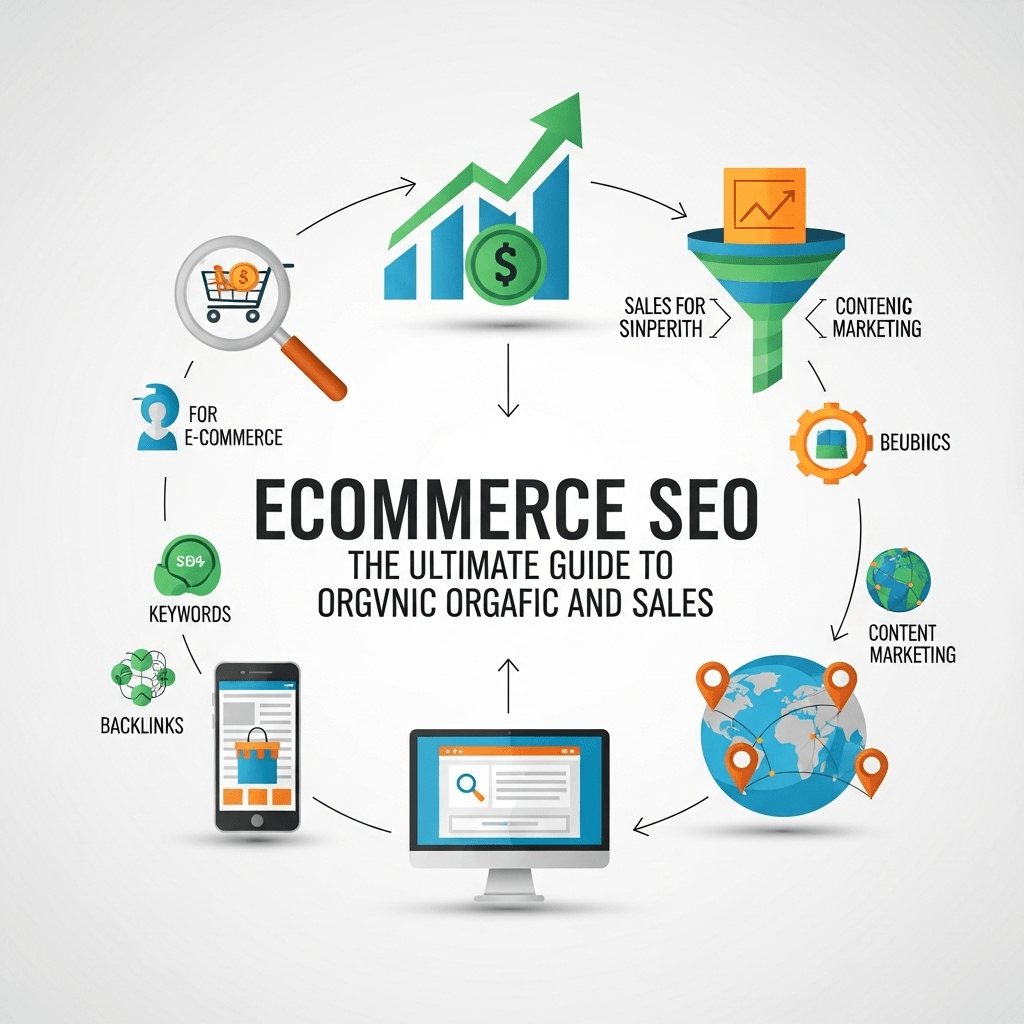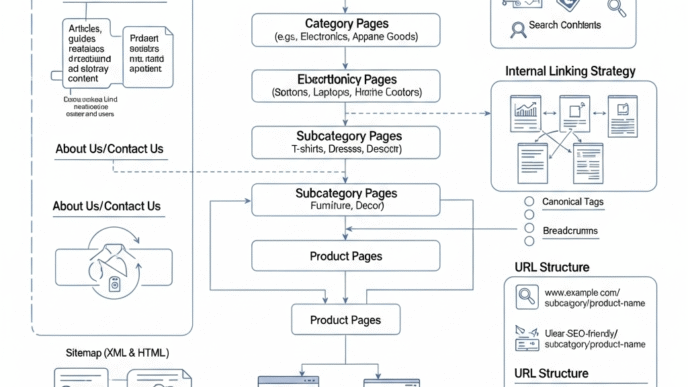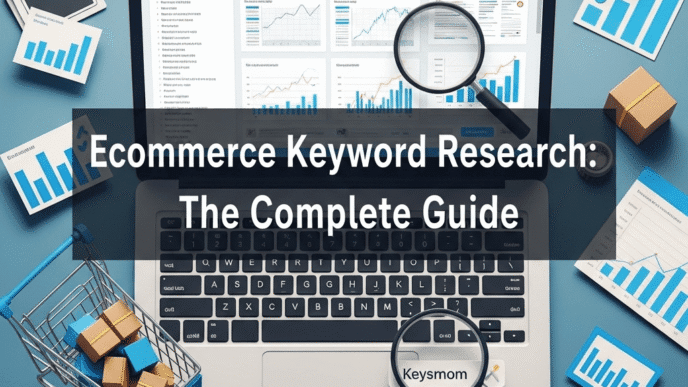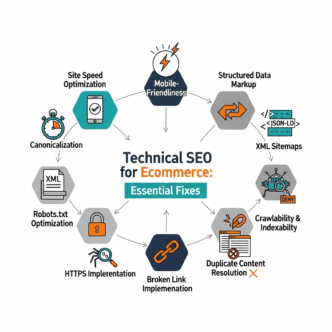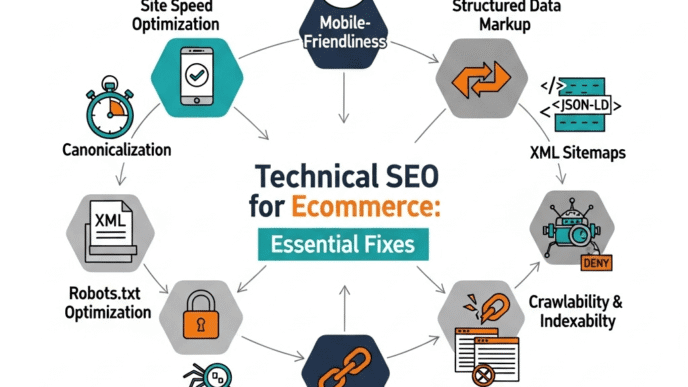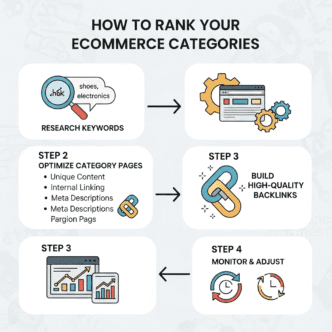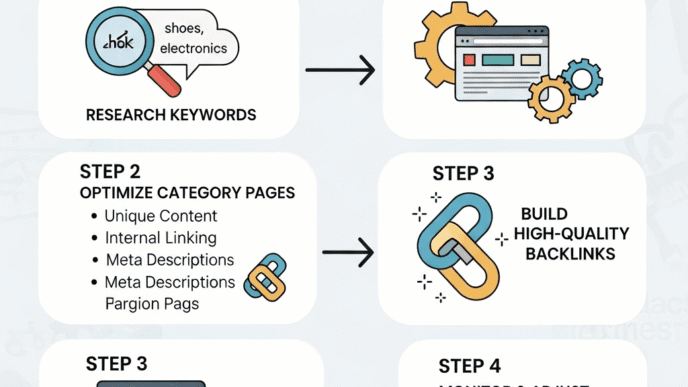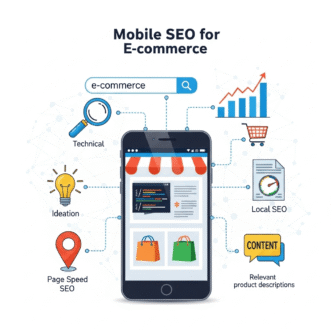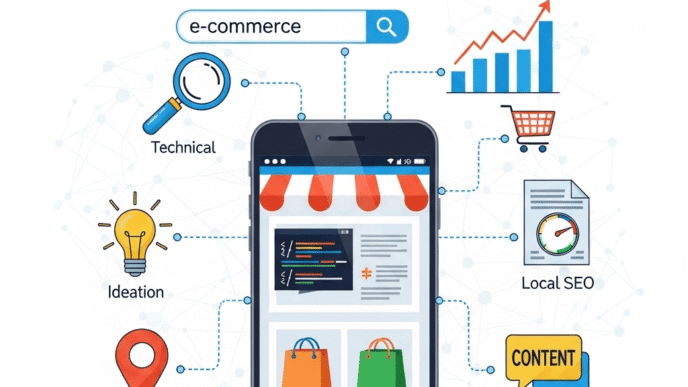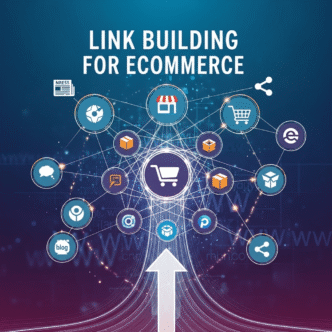Ever feel like your online store is a needle in a haystack? You’ve got amazing products, competitive prices, and a slick website—but somehow, customers just aren’t finding you. Meanwhile, your competitors seem to be swimming in organic traffic.
Here’s the truth: ecommerce SEO isn’t just nice to have anymore—it’s your ticket to sustainable growth without burning through ad budgets. This ecommerce SEO guide will walk you through everything you need to transform your online store from invisible to irresistible in search results.
Let’s dive in.
Table of Contents
ToggleWhat is Ecommerce SEO and Why Should You Care?
Think of ecommerce SEO as your store’s 24/7 salesperson who never takes a coffee break.
It’s the process of optimizing your online store so search engines like Google can find, understand, and rank your product pages higher. When someone searches for “organic cotton t-shirts” or “best running shoes for flat feet,” you want YOUR store popping up on page one.
The payoff? Unlike paid ads that stop working the moment you stop paying, SEO for ecommerce websites builds long-term traffic that compounds over time. We’re talking about customers who are actively searching for what you sell—high-intent buyers with credit cards ready.
Pro Tip: According to BrightEdge research, organic search drives 53.3% of all website traffic, making it the single most important channel for ecommerce growth. That’s more than half your potential sales sitting on the table if you’re ignoring SEO.
How is Ecommerce SEO Different from Regular SEO?
Good question. While the fundamentals overlap, ecommerce search engine optimization has its own unique challenges.
Regular blogs might target one keyword per page. Your store? You’ve got thousands of product pages, category pages, and filtering options that can create duplicate content nightmares.
Here’s what makes ecommerce SEO strategy special:
- Massive site architecture with hundreds or thousands of pages
- Product pages that need to rank AND convert
- Inventory changes that can create dead links
- Duplicate content issues from manufacturer descriptions
- Technical SEO complexity with faceted navigation and filters
Think of it this way: a regular website is like managing a boutique hotel, while an ecommerce store is like running a mega-mall. Different scale, different rules.
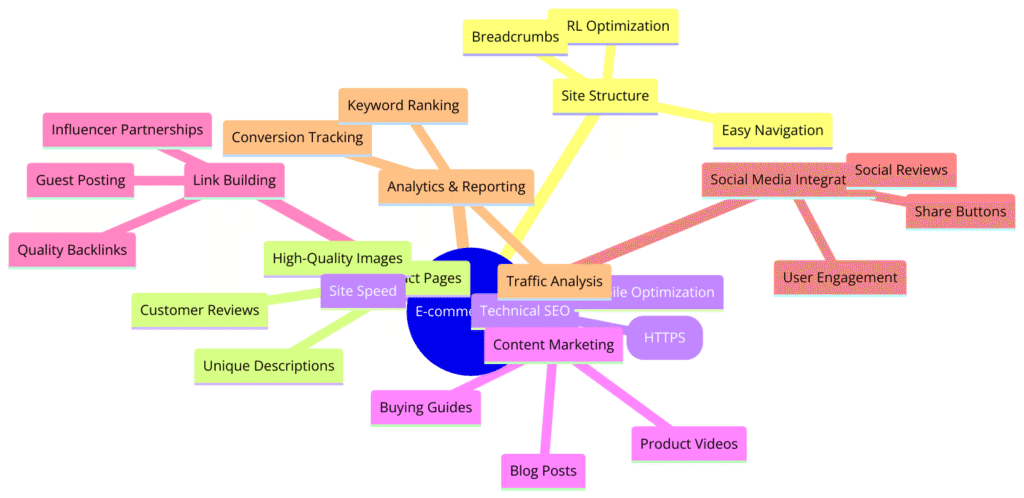
What Are the Core Pillars of Ecommerce SEO?
Let’s break down the foundation of a solid ecommerce SEO checklist. Master these, and you’re golden.
1. Technical SEO for Ecommerce
This is your website’s plumbing. Boring? Maybe. Essential? Absolutely.
Site speed matters more than you think. Research from Portent shows that conversion rates drop by an average of 0.3% for every additional second of load time between 0-5 seconds. If your pages load slower than a snail on vacation, customers bounce before they even see your products.
Mobile optimization isn’t optional anymore—it’s the law of the land. Statista reports that mobile commerce accounted for 60.7% of all ecommerce sales in 2024. If your site looks broken on a phone, you’re literally turning away the majority of your potential customers.
Pro Tip: Use Google’s PageSpeed Insights to audit your site speed. Aim for a score above 90 on mobile. Compress images, enable browser caching, and consider a Content Delivery Network (CDN) to speed things up.
2. Site Architecture and Navigation
Imagine walking into a grocery store where the milk is next to the motor oil. Confusing, right?
Your ecommerce site structure should make it ridiculously easy for both customers AND search engines to find products. The golden rule: every product should be reachable within three clicks from your homepage.
Use a logical hierarchy:
- Homepage → Category Pages → Subcategory Pages → Product Pages
Implement breadcrumb navigation so users (and Google) always know where they are. It looks like this: Home > Men’s Clothing > T-Shirts > Organic Cotton Tees.
3. Keyword Research for Ecommerce
This is where the magic starts. Ecommerce keyword research tells you exactly what your customers are typing into Google.
Don’t just target broad terms like “shoes.” That’s like fishing in the ocean with a safety pin. Go for long-tail keywords for ecommerce like:
- “waterproof hiking boots for wide feet”
- “affordable organic baby clothes”
- “best gaming laptop under $1000”
These longer, specific phrases have less competition and higher purchase intent. Someone searching for “laptops” might be doing homework. Someone searching “best gaming laptop under $1000” is ready to buy TODAY.
Pro Tip: Use tools like Google Keyword Planner, Ahrefs, or SEMrush to find keywords with decent search volume (500+ monthly searches) and manageable competition. Look for keywords with commercial intent—words like “buy,” “best,” “review,” or “cheap.”
How Do You Optimize Product Pages for Search Engines?
Your product pages are where the money lives. Let’s make them irresistible to both Google and customers.
Writing Product Descriptions That Actually Sell
Please, for the love of all that’s holy, don’t copy manufacturer descriptions. Google hates duplicate content, and customers can smell generic copy from a mile away.
Write unique product descriptions that include:
- Your target product page SEO keywords naturally
- Benefits, not just features (don’t say “3000 mAh battery,” say “lasts all day on a single charge”)
- Sensory details that help customers imagine using the product
- Social proof like ratings or testimonials
Aim for at least 300 words for main products, 150-200 for variations. Yes, this takes time. No, there’s no shortcut that works.
Optimizing Product Images
Images sell products, but they can also tank your site speed if you’re not careful.
Here’s the checklist:
- Compress images without losing quality (use tools like TinyPNG)
- Use descriptive file names like “red-leather-handbag-front-view.jpg” instead of “IMG_12345.jpg”
- Write alt text for ecommerce images that describes what’s in the photo: “Woman carrying red leather handbag with gold buckle”
- Include multiple angles and lifestyle shots showing the product in use
Pro Tip: Alt text serves two purposes—it helps visually impaired users understand your content AND gives Google context about your images. Win-win.
Product Schema Markup
This is the secret sauce most store owners ignore. Product schema markup is code that tells Google exactly what’s on your page.
With schema, your products can show up with:
- Star ratings
- Pricing information
- Stock availability
- Product reviews
These rich snippets make your listing stand out in search results like a peacock in a parking lot. Higher click-through rates = more traffic = more sales.
Use Google’s Schema Markup Validator to test your implementation and ensure it’s working correctly.
What Role Do Category Pages Play in Ecommerce SEO?
Category pages are the unsung heroes of ecommerce SEO best practices. While everyone obsesses over individual products, smart store owners optimize their category pages to capture broader traffic.
Why Category Pages Matter
Think about search behavior. Someone searching “running shoes” isn’t ready to commit to a specific product. They want options. Your category page should rank for this term and showcase your best products.
These pages can rank for competitive ecommerce keywords that would be impossible for individual product pages to target.
How to Optimize Category Pages
Start with a compelling category description (300-500 words minimum) that includes:
- Your main category keyword naturally
- What makes your products different
- Who these products are for
- Buying guides or tips
Don’t bury this text at the bottom where nobody sees it. Put at least a paragraph above the products, then expand below if needed.
Use internal linking strategically. Link to related categories, popular products, and helpful blog content. This distributes link equity across your site and helps customers discover more products.
Pro Tip: Update your category pages seasonally. A “Winter Jackets” page should look different in November than it does in April. This freshness signals to Google that your site is active and relevant.
How Important is Content Marketing for Ecommerce SEO?
Spoiler alert: it’s HUGE. Ecommerce content marketing is how you rank for all those juicy informational keywords that bring in top-of-funnel traffic.
The Power of Blog Content
Not every search has buying intent. Someone searching “how to choose running shoes” isn’t ready to purchase—they’re researching. But if you help them NOW with great content, they’ll remember you when they ARE ready to buy.
Create blog posts targeting:
- How-to guides: “How to measure your ring size at home”
- Buying guides: “Ultimate guide to choosing the best yoga mat”
- Comparison posts: “Memory foam vs latex mattresses”
- Problem-solution content: “5 ways to stop shoes from squeaking”
Each post should naturally link to relevant products. You’re not being pushy—you’re being helpful.
Building Topical Authority
Google loves websites that demonstrate deep expertise. By creating comprehensive content around your niche, you build topical authority in ecommerce.
If you sell coffee equipment, don’t just write one article about espresso. Cover:
- Different brewing methods
- Coffee bean origins
- Grinder comparisons
- Maintenance guides
- Troubleshooting common issues
Become the go-to resource. Google will reward you with better rankings across your entire site.
Pro Tip: Create a content calendar and publish consistently. One amazing post per week beats five mediocre posts. Quality always trumps quantity in 2025’s SEO landscape.
What Technical Issues Kill Ecommerce SEO Rankings?
Let’s talk about the silent killers—technical problems that sabotage your rankings without you even knowing.
Duplicate Content Problems
This is the biggest headache in ecommerce technical SEO. When you have:
- Similar products with slight variations
- Manufacturer descriptions across multiple sites
- Pagination creating multiple URLs for the same content
- Filter parameters generating unique URLs
Google gets confused about which page to rank. The solution? Use canonical tags to tell Google which version is the “real” one.
For filtered URLs (like “/shoes?color=red&size=10”), canonicalize back to the main category page or use a noindex tag if the filtered page doesn’t deserve to rank.
Handling Out-of-Stock Products
Your best-selling widget just sold out. Now what?
DON’T delete the page. If it ranked well, you’ve just thrown away valuable SEO equity. Instead:
- Keep the page live with an “Out of Stock” notice
- Add a “Notify Me” button for restocks
- Suggest similar alternative products
- Update the schema markup to show unavailability
If it’s permanently discontinued, set up a 301 redirect to the most similar product or category page.
Site Speed and Core Web Vitals
Google’s Core Web Vitals measure user experience through three metrics:
- Largest Contentful Paint (LCP): How fast your main content loads (target: under 2.5 seconds)
- Interaction to Next Paint (INP): How quickly your site responds to interactions (target: under 200ms)
- Cumulative Layout Shift (CLS): How much your page jumps around while loading (target: under 0.1)
Poor scores here will absolutely hurt your ecommerce website rankings. Fix it by:
- Optimizing images (compress, lazy load)
- Minimizing JavaScript
- Using a fast hosting provider
- Implementing a CDN
How Do You Build Links for an Ecommerce Store?
Link building for ecommerce is different from other industries. Nobody’s going to naturally link to your product pages (sorry, but it’s true).
Content-Driven Link Building
This is where your blog content shines. Create resources that OTHER websites want to link to:
- Original research: Survey your customers and publish the results
- Ultimate guides: Comprehensive resources that become industry references
- Infographics: Visual content that others embed and link back to
- Tools and calculators: Interactive resources (like a “dress size converter” for a fashion store)
These assets attract natural links that boost your entire domain’s authority.
Strategic Partnerships
Look for ecommerce link building opportunities through:
- Supplier and manufacturer relationships (ask for a mention on their site)
- Industry associations and directories
- Partnerships with complementary brands
- Guest posts on relevant blogs
- Product reviews from bloggers and influencers
Quality beats quantity. One link from a highly authoritative site in your niche is worth more than 100 links from random directories.
Pro Tip: Create a “Best [Your Product]” list that includes your competitors. Sounds crazy, but it attracts links from people searching for unbiased comparisons. Just make sure your product genuinely deserves to be on the list.
What Are the Best Ecommerce SEO Tools You Need?
Let’s talk tools. You can’t optimize what you can’t measure.
Essential SEO Tools Comparison
| Tool | Best For | Price Range | Key Features |
|---|---|---|---|
| Google Search Console | Monitoring performance, finding errors | Free | Click data, indexing issues, mobile usability |
| Google Analytics 4 | Traffic analysis, conversion tracking | Free | User behavior, traffic sources, goal tracking |
| Ahrefs | Competitor research, backlink analysis | $99-$999/mo | Keyword research, site audits, rank tracking |
| SEMrush | All-in-one SEO platform | $119-$449/mo | Technical audits, keyword tracking, content ideas |
| Screaming Frog | Technical site audits | Free-$259/yr | Crawl analysis, broken links, duplicate content |
| Shopify SEO Apps | Platform-specific optimization | $0-$50/mo | Automated technical fixes, structured data |
Which Tools Do You Actually Need?
Start with the free ones: Google Search Console and Google Analytics. These give you 80% of what you need.
As you grow, invest in either Ahrefs or SEMrush for ecommerce keyword tracking and competitive analysis. Don’t buy both—pick one and master it.
For technical audits, Screaming Frog’s free version handles sites up to 500 URLs. Upgrade if you have a larger store.
How Do You Measure Ecommerce SEO Success?
You can’t improve what you don’t measure. Here are the metrics that actually matter.
Key Performance Indicators (KPIs)
Forget vanity metrics. Focus on:
Organic Traffic Growth: Are you getting more visitors from search engines month over month?
Keyword Rankings: Track your position for target keywords, especially high-converting ecommerce keywords.
Organic Revenue: This is the big one. Traffic is nice, but revenue pays the bills. Use Google Analytics to track revenue from organic search.
Conversion Rate: Are your organic visitors actually buying? Compare organic conversion rates to other channels.
Page Load Speed: Monitor Core Web Vitals regularly. Slow sites bleed money.
Setting Realistic Expectations
Here’s the hard truth: ecommerce SEO results take time. Unlike paid ads, you won’t see instant gratification.
Typical timeline:
- Months 1-3: Technical foundation and content creation
- Months 4-6: Initial ranking improvements for long-tail keywords
- Months 6-12: Significant traffic growth and revenue impact
- 12+ months: Compounding returns and competitive advantage
Don’t expect overnight miracles. Consistent effort beats sporadic brilliance every time.
Pro Tip: Set up automated weekly reports in Google Analytics showing organic traffic, revenue, and top-performing pages. Review these every Monday to spot trends early.
What Are Common Ecommerce SEO Mistakes to Avoid?
Let’s save you some headaches. Here are the blunders I see constantly that torpedo otherwise solid ecommerce SEO strategies.
Mistake #1: Thin Product Descriptions
Slapping up 50 words of generic manufacturer copy is SEO suicide. Google needs substantial, unique content to understand what you’re selling.
The Pitfall: Using the same descriptions as 50 other retailers means you’re competing with exact duplicate content. Google picks ONE version to rank—and it probably won’t be yours.
Fix: Write comprehensive descriptions (300+ words for main products). Include use cases, specifications, what makes this product special, and answer common customer questions. Yes, this takes time. No, there’s no shortcut that works long-term.
Mistake #2: Ignoring User Intent
Ranking for “cheap watches” sounds great until you realize people searching this are price-shopping tire-kickers, not your ideal customers.
The Pitfall: Chasing high-volume keywords without considering what the searcher actually wants leads to tons of traffic but zero sales. You’ll celebrate your traffic spike while your conversion rate tanks.
Fix: Target keywords that match your business model. If you sell premium products, target “best [product]” or “high-quality [product]” instead. Match keywords to your customer’s journey stage.
Mistake #3: Deleting Out-of-Stock Product Pages
Your best-selling item sold out, so you delete the page. Congratulations—you just threw away months of SEO work and valuable backlinks.
The Pitfall: Deleted pages return 404 errors, frustrating users and wasting any link equity that page earned. Plus, you’re back at square one when the product restocks.
Fix: Keep the page live with clear “Out of Stock” messaging, email notification signups, and recommendations for similar products. If it’s permanently discontinued, 301 redirect to the most relevant alternative.
Mistake #4: Forgetting About Internal Linking
Your product pages are orphans if nothing links to them. Google’s crawlers might never even find them, and they definitely won’t understand their importance.
The Pitfall: Internal linking helps search engines discover new pages and understand your site structure, yet many ecommerce sites have weak internal linking architectures. Without strategic internal links, page authority doesn’t flow through your site.
Fix: Create a robust internal linking strategy for ecommerce by linking from:
- Related products (“You might also like…”)
- Category pages to featured products
- Blog posts to relevant products
- Homepage to priority categories
- Use descriptive anchor text that includes keywords
Mistake #5: Not Optimizing for Mobile Users
Over 60% of ecommerce traffic is mobile. If your site sucks on phones, you’re toast.
The Pitfall: Desktop-first design often creates mobile experiences with tiny buttons, impossible-to-read text, and checkout flows that require a magnifying glass. Mobile users bounce faster than a rubber ball.
Fix: Use responsive design, make buttons finger-friendly (minimum 44×44 pixels), ensure text is readable without zooming, and test checkout on actual devices. Don’t rely solely on Chrome’s device emulator.
Mistake #6: Neglecting HTTPS Security
Running an ecommerce store without HTTPS in 2025 is like leaving your shop’s front door wide open at night.
The Pitfall: Google has used HTTPS as a ranking signal since 2014, and browsers now flag non-HTTPS sites as “Not Secure. This terrifies customers who are about to enter credit card information. Plus, you’re actively hurting your rankings.
Fix: Install an SSL certificate immediately. Most hosting providers offer free SSL certificates through Let’s Encrypt. Set up proper redirects from HTTP to HTTPS. It’s non-negotiable.
Mistake #7: Blocking Pages with Robots.txt or Noindex
I’ve seen stores accidentally block their entire product catalog because someone misconfigured their robots.txt file. That’s an expensive mistake.
The Pitfall: One wrong line in your robots.txt file can deindex your entire site. Similarly, leaving development noindex tags active after launch means Google can’t see your pages.
Fix: Use Google Search Console to test your robots.txt file. Regularly audit your site for noindex tags. When launching, create a pre-launch checklist that includes removing all crawl blockers.
Mistake #8: Obsessing Over Rankings Instead of Revenue
Ranking #1 for “red widgets” means nothing if those visitors don’t buy.
The Pitfall: Vanity metrics feel good but pay nothing. You can rank for dozens of keywords and still lose money if they’re the wrong keywords or your pages don’t convert.
Fix: Focus on commercial intent keywords and track revenue, not just rankings. A #5 ranking that converts at 5% beats a #1 ranking that converts at 0.5%. Use Google Analytics to monitor organic revenue as your primary success metric.
Mistake #9: Creating Shallow Content at Scale
Using AI or cheap writers to pump out hundreds of thin blog posts might seem like a shortcut to SEO success. It’s not.
The Pitfall: Google’s helpful content system specifically targets sites that create content primarily for search engines rather than people. Thin, unhelpful content gets filtered out.
Fix: Create fewer, better pieces of content. One comprehensive 3,000-word guide that genuinely helps people beats ten 300-word fluff pieces. Invest in quality over quantity.
Mistake #10: Ignoring Local SEO (If You Have Physical Locations)
If you have brick-and-mortar stores alongside your ecommerce site, ignoring local SEO leaves money on the table.
The Pitfall: “Buy [product] near me” and “where to buy [product] in [city]” are high-intent searches. Without local optimization, you’re invisible to customers who might visit today.
Fix: Set up and optimize your Google Business Profile, implement local schema markup, create location-specific pages if you have multiple stores, and encourage customer reviews.
Mistake #11: Not Updating Product Information
Products change—features get upgraded, prices shift, availability fluctuates. Stale information frustrates customers and signals to Google that your site isn’t maintained.
The Pitfall: Nothing kills trust faster than seeing a product marked “in stock” only to discover it’s been sold out for weeks. Or showing last year’s price and model.
Fix: Implement systems to keep product data current. If you use inventory management software, integrate it with your website. Set up regular audits to catch discrepancies. Update schema markup when key details change.
Mistake #12: Overusing Exact Match Keywords (Keyword Stuffing)
“Buy red shoes cheap red shoes best red shoes for sale” isn’t SEO—it’s spam.
The Pitfall: Keyword stuffing makes your content unreadable and triggers Google’s spam filters. Modern search algorithms understand natural language and semantic relationships.
Fix: Write naturally for humans first. Use your primary keyword in the title, first paragraph, and a few times naturally throughout. Focus on comprehensive coverage of the topic rather than keyword density. Google’s smart enough to understand synonyms and related concepts.
How is AI Changing Ecommerce SEO in 2025?
Let’s address the elephant in the room: AI is reshaping search, and you need to adapt.
AI Overviews and Zero-Click Searches
Google’s AI-powered overviews now appear for many searches, summarizing information directly in search results. Studies show that zero-click searches—where users get their answer without clicking through—now account for nearly 60% of all Google searches.
What this means for your ecommerce store:
- Position for featured snippets: Structure content to answer questions clearly with concise paragraphs
- Focus on branded searches: Build brand recognition so people specifically search for YOU
- Create value beyond basic info: Offer unique insights, tools, or experiences that AI summaries can’t replicate
- Optimize for AI-powered product recommendations: Ensure your schema markup is comprehensive so AI systems can understand your products
AI-Powered Product Descriptions and Content
Tools like ChatGPT can help generate product descriptions, but here’s the catch: so can your competitors. Don’t just use AI output verbatim.
Smart approach for using AI in ecommerce SEO:
- Use AI for first drafts and ideation
- Add your unique brand voice and personality
- Include specific product knowledge from actual testing
- Incorporate real customer insights and reviews
- Add unique selling propositions AI wouldn’t know
The human touch is what differentiates you. Google’s guidance emphasizes creating helpful, people-first content that demonstrates experience and expertise—something AI alone can’t fake.
Voice Search and Conversational Queries
More people are searching by voice: “Hey Google, where can I buy organic dog food near me?
Optimize for voice search in ecommerce by:
- Using natural, conversational language in your content
- Answering specific questions clearly and concisely
- Targeting long-tail question keywords (“where can I find,” “what’s the best,” “how do I choose”)
- Implementing FAQ schema markup
- Optimizing for local searches if you have physical locations
Pro Tip: Create FAQ sections on product and category pages that answer common voice search queries. These often get pulled into featured snippets and voice search results, giving you prime real estate in AI-powered answers.
AI-Powered Personalization
Search engines are getting smarter about understanding user intent and personalizing results. The same query might show different results to different users based on their location, search history, and behavior.
How to adapt:
- Create content that serves multiple user intents (informational, commercial, transactional)
- Use structured data to help AI understand your content’s purpose
- Build comprehensive topic clusters that answer questions at every stage of the buyer journey
- Focus on creating genuinely helpful content that satisfies user needs
Visual and Multimodal Search
Google Lens and similar technologies let users search by image, voice, and text simultaneously. Visual search is growing rapidly, with Pinterest reporting that visual searches on their platform increased by 60% year-over-year.
Prepare your ecommerce store by:
- Using high-quality, diverse product images from multiple angles
- Implementing proper image schema markup
- Including detailed, descriptive alt text for all images
- Using descriptive file names (not IMG_12345.jpg)
- Creating lifestyle images showing products in real-world contexts
What’s the Future of Ecommerce SEO?
Crystal ball time. Where is this all heading?
User Experience Becomes Even More Critical
Google’s algorithm increasingly prioritizes sites that provide excellent user experiences. UX and SEO for ecommerce are no longer separate disciplines—they’re intertwined.
Expect Google to measure:
- How long people spend on your site
- Whether they find what they need quickly
- If they return to search results (pogo-sticking—a bad sign)
- Navigation ease and friction points
- Mobile usability and interaction quality
E-E-A-T Gets More Important
Google’s E-E-A-T framework (Experience, Expertise, Authoritativeness, Trustworthiness) is becoming crucial, especially for online shopping SEO.
Demonstrate E-E-A-T by:
- Showing real product testing and hands-on experience
- Featuring expert contributors and their credentials
- Building authoritative backlinks from industry leaders
- Displaying trust signals (secure checkout, return policy, customer service info)
- Showcasing authentic customer reviews and testimonials
Sustainability and Ethical Shopping
Consumers increasingly search for “sustainable,” “eco-friendly,” “ethical,” and “fair trade” products. If this describes your brand, optimize for these trending ecommerce keywords.
Create content about:
- Your sourcing practices and supply chain
- Environmental impact and carbon footprint
- Certifications and sustainability standards
- Ethical manufacturing and fair labor practices
- Product lifecycle and recyclability
This isn’t just good SEO—it’s good business that resonates with conscious consumers.
Video Content Dominance
Video is exploding as a search medium. YouTube is the world’s second-largest search engine, and Google increasingly surfaces video content in search results.
Capitalize on video SEO by:
- Creating product demonstration videos
- Producing how-to guides and tutorials
- Sharing customer testimonial videos
- Optimizing video titles, descriptions, and tags with keywords
- Embedding videos on product pages (boosts engagement metrics)
Real-World Ecommerce SEO Case Study
Let’s look at a concrete example (anonymized for privacy).
The Store: Specialty outdoor gear retailer with 500 products, competing in a saturated market
The Challenge: Competing against giants like REI and Amazon with a limited budget and minimal brand recognition
The Strategy:
- Targeted ultra-specific long-tail keywords like “lightweight backpacking tent for tall people” and “best hiking boots for wide feet with plantar fasciitis”
- Created comprehensive buying guides for each product category (15 detailed guides totaling 45,000 words)
- Built topical authority through blog content on camping, hiking, and outdoor skills (2 posts per week for 12 months)
- Implemented proper schema markup on all product pages with ratings, pricing, and availability
- Fixed critical technical issues (reduced page load time from 6.2s to 1.8s, fixed 300+ broken links)
- Built relationships with outdoor bloggers and secured 47 quality backlinks
- Rewrote all product descriptions to be unique and comprehensive (averaging 400 words each)
The Results (12 months):
- Organic traffic increased 287% (from 8,200 to 31,700 monthly visitors)
- Revenue from organic search grew 412% (from $24,000 to $122,880 monthly)
- Ranked on page one for 143 commercial keywords
- Average order value from organic traffic was 22% higher than paid traffic
- Reduced paid ad spend by 30% while maintaining overall revenue growth
- Email list grew by 890% from content lead magnets
The Key Takeaway: You don’t need to outrank Amazon for “camping tents.” You need to own the niche terms that your ideal customers are searching for. Ultra-specific long-tail keywords had less competition and higher conversion rates—exactly what a smaller ecommerce store needs.
Your Ecommerce SEO Action Plan
Feeling overwhelmed? Let’s break this down into actionable steps.
Month 1: Foundation and Audit
Week 1-2:
- Audit your site using Screaming Frog or SEMrush
- Document all critical technical issues
- Set up Google Search Console and Google Analytics 4
- Install and configure essential schema markup
Week 3-4:
- Fix critical technical issues (broken links, 404s, redirect chains)
- Implement HTTPS if not already secure
- Optimize site speed (compress images, enable caching)
- Fix mobile usability issues
Month 2-3: Keyword Research and Content Optimization
Month 2:
- Conduct comprehensive keyword research for top 20 products
- Identify 50-100 high-intent ecommerce keywords to target
- Map keywords to existing pages (products, categories, blog posts)
- Create content gap analysis
Month 3:
- Rewrite product descriptions for top 20 bestsellers (300+ words each)
- Optimize category pages with unique descriptions (500+ words)
- Improve internal linking between related products and categories
- Optimize all images (compress, rename files, add descriptive alt text)
Month 4-6: Content Creation and Link Building
Ongoing (2-4 posts per month):
- Create comprehensive buying guides for major categories
- Publish how-to guides targeting informational keywords
- Write comparison posts addressing common customer questions
- Develop FAQ content that targets voice search queries
Link Building:
- Identify 20 potential link partners (complementary businesses, suppliers, bloggers)
- Create linkable assets (original research, comprehensive guides, tools)
- Reach out to 5-10 prospects per week
- Monitor backlink profile growth
Month 7-12: Scale and Optimize
Content Expansion:
- Expand blog content to 2-4 posts weekly
- Create video content for top products
- Develop interactive tools or calculators if relevant
- Build topical authority clusters
Optimization:
- Review and update underperforming product pages
- A/B test product page elements for conversion
- Refresh old blog content with updated information
- Monitor Core Web Vitals and maintain performance
Analytics Review:
- Weekly: Traffic, rankings, and revenue trends
- Monthly: Deep dive into conversion rates by keyword/page
- Quarterly: Comprehensive SEO audit and strategy adjustment
Pro Tip: Don’t try to do everything at once. Pick 3-5 priority actions each month and execute them excellently. Consistent progress beats overwhelming yourself into paralysis. Remember: ecommerce SEO is a marathon, not a sprint.
Frequently Asked Questions About Ecommerce SEO
How long does it take to see results from ecommerce SEO?
Honestly? Expect 4-6 months before you see meaningful results, and 12+ months for substantial ROI.
Long-tail keywords might rank within 2-3 months, but competitive terms take longer. Unlike paid ads that deliver instant traffic, SEO is a compound investment. The good news? Once you start ranking, that traffic keeps flowing without ongoing ad spend.
What’s the difference between on-page and off-page ecommerce SEO?
On-page SEO is everything you control on your website: content, meta tags, images, internal links, site speed, and user experience. It’s about making your pages as relevant and user-friendly as possible.
Off-page SEO is everything outside your site, primarily backlinks from other websites. It’s about building authority and trust signals that tell Google your site deserves to rank.
You need both. Great content without backlinks won’t rank. Lots of backlinks pointing to terrible content won’t convert.
Can I do ecommerce SEO myself, or do I need an agency?
You can absolutely start with DIY ecommerce SEO optimization.
Can I do ecommerce SEO myself, or do I need an agency?
You can absolutely start with DIY ecommerce SEO optimization.
If you have the time to learn and implement, handle the basics yourself: keyword research, content creation, technical fixes, and on-page optimization. The tools and resources exist—you just need the commitment.
Hire an agency or consultant when:
- Your store generates \$50K+ monthly revenue (the ROI justifies the investment)
- You lack the time to execute consistently
- Technical SEO issues are beyond your expertise
- You need link building at scale
- You want faster results through experienced execution
Many successful stores start DIY for 6-12 months, then hire experts to scale what’s working.
How much does ecommerce SEO cost?
Prices vary wildly based on store size and competition.
DIY costs: $100-$500/month for tools (SEMrush, Ahrefs, etc.)
Freelancer rates: \$500-\$2,500/month for basic optimization and content creation
Agency pricing: $2,000-$10,000+/month for comprehensive services including technical SEO, content strategy, and link building
One-time audits: \$1,000-\$5,000 for comprehensive site audits
The real question isn’t cost—it’s ROI. If spending $3,000/month generates an additional $15,000 in organic revenue, that’s a no-brainer investment.
What’s better for ecommerce: SEO or paid ads?
Why choose? You need both, but for different reasons.
Paid ads give you:
- Immediate traffic and sales
- Precise targeting and testing
- Predictable results
- But… they stop the moment you stop paying
SEO gives you:
- Compounding long-term growth
- Higher profit margins (no ad cost per sale)
- Brand authority and trust
- But… it takes months to gain momentum
The smartest strategy? Use paid ads for immediate revenue while building your SEO foundation. As organic traffic grows, reduce ad spend proportionally.
How often should I update my product pages for SEO?
Major updates: Annually or when products significantly change
Minor tweaks: Quarterly to refresh content and maintain relevance
Immediate updates: Whenever pricing, availability, or key features change
Google favors fresh, accurate content. Set calendar reminders to review your top 20% of products every quarter. Update descriptions, add new customer reviews, refresh images, and ensure information accuracy.
Don’t update just for the sake of it, though. Make meaningful improvements that help customers make better buying decisions.
Does social media affect ecommerce SEO?
Directly? Not really. Social signals aren’t a ranking factor.
Indirectly? Absolutely. Here’s how:
- Social traffic can lead to natural backlinks when people discover and share your content
- Social presence builds brand awareness, increasing branded searches (which ARE good for SEO)
- Social platforms drive traffic that improves engagement metrics
- Active social channels signal legitimacy and trustworthiness
Think of social media as a complementary channel, not an SEO tactic. Focus on platforms where your customers actually hang out.
What’s the ideal product description length for SEO?
Minimum: 150-200 words for basic products
Ideal: 300-500 words for main products and bestsellers
Comprehensive: 800-1,200+ words for high-ticket or complex products
But length alone doesn’t matter—depth and usefulness do. A 300-word description that answers every customer question beats a 1,000-word description full of fluff.
Include:
- Product benefits (not just features)
- Use cases and applications
- Technical specifications
- Who this product is for
- What makes it different
- Common questions answered
How do I handle duplicate content with product variations?
This trips up almost every store. When you have the same product in multiple colors or sizes, how do you avoid duplicate content?
Strategy 1: Canonical tags (best for minor variations)
- Create separate URLs for each variation
- Use canonical tags pointing to the main version
- Google indexes the main page, users can still browse variations
Strategy 2: Single page with dynamic content (best for simple variations)
- One URL with dropdown/button selectors for variations
- Content stays the same, only price/availability changes
- Cleaner user experience, no duplicate content issues
Strategy 3: Unique content for each variation (best for significantly different products)
- Write unique descriptions highlighting what makes each variation special
- Example: “Red leather handbag” gets different copy than “Black leather handbag”
- More work, but creates more ranking opportunities
Should I use manufacturer product descriptions?
Short answer: No. Never. Not even once.
Long answer: Thousands of other retailers use the same manufacturer copy. Google shows ONE version—probably not yours. You’re competing with identical content, which is impossible to win.
Even if rewriting seems overwhelming:
- Start with your top 20% products (80/20 rule applies here)
- Use manufacturer specs as a starting point, then add unique insights
- Include customer language from reviews
- Focus on benefits specific to your target customer
Yes, it’s time-consuming. Yes, it’s necessary. There’s no shortcut here that actually works.
How important are customer reviews for ecommerce SEO?
Incredibly important for multiple reasons:
SEO benefits:
- Fresh, unique content added regularly
- Natural keyword usage from customer language
- Review schema in search results increases click-through rates
- More time on page as shoppers read reviews
Conversion benefits:
- 93% of consumers say reviews influence purchasing decisions
- Products with reviews convert 3.5x better than products without
- Reviews answer questions you might not think to address
How to get more reviews:
- Send automated email requests 7-10 days after delivery
- Offer small incentives (discount codes, loyalty points)
- Make leaving reviews ridiculously easy (one-click process)
- Display reviews prominently to show you value feedback
Pro Tip: Respond to reviews (positive and negative). It shows you care, provides additional content, and builds trust with potential customers.
What’s the best ecommerce platform for SEO?
The honest answer? Most modern platforms handle SEO fine if configured correctly.
Platform comparison:
Shopify:
- ✅ Easy to use, built-in SEO features
- ✅ Fast loading speeds with good hosting
- ❌ Limited URL structure customization
- ❌ /collections/ and /products/ in URLs can’t be removed
WooCommerce (WordPress):
- ✅ Complete control over every SEO element
- ✅ Massive plugin ecosystem
- ❌ Requires more technical knowledge
- ❌ Speed depends on hosting quality
BigCommerce:
- ✅ Strong built-in SEO features
- ✅ No transaction fees
- ❌ Steeper learning curve
- ❌ Theme customization more complex
Magento:
- ✅ Powerful for large catalogs
- ✅ Extremely customizable
- ❌ Requires developer expertise
- ❌ Expensive to maintain
The verdict: Pick the platform that fits your technical skill level and budget. You can succeed with SEO on any of them—execution matters more than platform.
How do I optimize for local ecommerce searches?
Even online stores benefit from local SEO for ecommerce if you have physical locations or serve specific regions.
Local optimization strategies:
- Create and optimize your Google Business Profile
- Add location pages for each physical store
- Include city/region keywords naturally in content (“Buy organic skincare in Austin”)
- Get listed in local directories
- Encourage reviews mentioning locations
- Use local schema markup (LocalBusiness schema)
- Create location-specific content (local buying guides, regional shipping info)
Searches like “where to buy [product] near me” or “best [product] in [city]” represent high-intent local traffic.
Can I recover from a Google penalty?
Yes, but it requires identifying the issue and fixing it thoroughly.
Common penalties and fixes:
Manual penalty:
- Check Google Search Console for penalty notifications
- Fix the issue (remove bad links, eliminate thin content, etc.)
- Submit a reconsideration request with detailed fixes
Algorithm update impact:
- Not technically a “penalty” but feels like one
- Review what the update targeted (content quality, links, technical issues)
- Make genuine improvements aligned with Google’s guidelines
- Recovery takes time—sometimes months
Prevention is easier than recovery:
- Never buy links
- Don’t use spammy SEO tactics
- Create genuinely helpful content
- Follow Google’s guidelines
Should I target zero-search-volume keywords?
Surprisingly, yes—especially for ecommerce.
Keyword tools often show “0” searches for ultra-specific terms that actually get traffic. Someone DOES search for “waterproof hiking boots for women with wide feet and high arches”—just not frequently enough to register in tools.
Long-tail keywords with low or zero volume:
- Face almost no competition
- Convert extremely well (super specific intent)
- Collectively drive significant traffic
- Often indicate purchase readiness
Target these alongside higher-volume terms. One article can rank for hundreds of these ultra-specific variations.
Final Thoughts: Your Ecommerce SEO Journey Starts Now
Here’s the reality: ecommerce SEO isn’t a one-time project—it’s an ongoing commitment to making your store better for customers and search engines.
Every successful ecommerce brand you admire got there through consistent effort, not overnight hacks. They wrote better product descriptions. They created genuinely helpful content. They fixed technical issues one by one. They built relationships that led to quality backlinks.
The beautiful part? While your competitors chase the latest advertising platform or dump thousands into ads that disappear the moment budgets dry up, you’ll be building an asset that compounds over time. Traffic that flows to your store while you sleep. Customers who find you because you genuinely helped them solve a problem.
The truth about ecommerce SEO in 2025:
- It’s more accessible than ever with better tools and resources
- Competition is fierce, but opportunities exist in every niche
- AI is changing search, but human expertise and experience still win
- Technical excellence matters, but user experience matters more
- Content quality beats content quantity every single time
- Long-term thinking beats short-term tactics
Yes, it takes patience. Yes, it requires consistent effort. Yes, you’ll face setbacks and algorithm updates that temporarily hurt rankings.
But the stores that win in ecommerce aren’t the ones with the biggest ad budgets—they’re the ones that play the long game. They build brands people search for by name. They create resources so valuable that others naturally link to them. They optimize relentlessly based on data, not hunches.
According to BrightEdge research, organic search now influences 51% of all revenue across industries. For ecommerce specifically, that number is even higher. Can you really afford to ignore the channel that drives over half of your potential revenue?
Your next steps:
Start small. Don’t try to implement everything in this guide simultaneously—you’ll burn out before making progress.
Pick ONE area to focus on this week:
- Fix your site speed if pages load slowly
- Rewrite descriptions for your top 5 products
- Create your first comprehensive buying guide
- Implement schema markup on key pages
- Build your first quality backlink
Next week, tackle another area. Then another. Six months from now, you’ll be shocked at your progress.
Remember: every product page you optimize is one more opportunity to be found. Every piece of helpful content you create is another door customers can walk through. Every technical issue you fix is one less barrier between you and revenue.
The best time to start your ecommerce SEO strategy was a year ago. The second-best time is today.
Your organic traffic (and your bank account) will thank you.
Now get out there and make your store impossible to ignore.
Ready to level up your ecommerce SEO game? Start by auditing your site with Google Search Console and Google PageSpeed Insights today. These free tools will reveal your biggest opportunities. Then pick one thing—just one—and do it excellently this week.
The journey of a thousand sales begins with a single optimization. Let’s go.
Ecommerce SEO Statistics 2025
Interactive Data Dashboard
Traffic Source Distribution
Key Insight: Organic search drives 53.3% of all website traffic
SEO Growth Timeline (12 Months)
Reality Check: 287% traffic growth and 412% revenue increase over 12 months
Conversion Rates by Channel
Why It Matters: Organic traffic brings higher conversion rates
Mobile vs Desktop Traffic
Mobile First: 60.7% of ecommerce sales happen on mobile
Page Speed Impact
Speed Kills Sales: Conversion drops 0.3% per second of load time
Transform Your Ecommerce SEO in 2025


